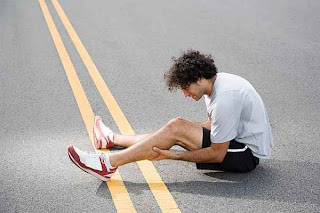Top 5 Painful Exercise Injuries to Avoid
When it comes to any exercise injury, prevention is best. You can avoid many injuries by training smart and listening to your body's warning signs.
Typical injuries I see in clients and others are many times related to soft tissues (i.e., tendons, ligaments, muscles, etc.). Treatment of any soft tissue injury during the first 24-72 hours is important to offset any further injury and inflammation. The general rule of thumb is to use the R.I.C.E.R. principle (REST, ICE, COMPRESSION, ELEVATION, REFERRAL FOR MEDICAL ASSISTANCE).
Here are my Top 5 Painful Exercise Injuries to Avoid:
1. Low back injuries and chronic injuries caused by over-training, poor technique, muscle imbalances and uncorrected postural deficiencies.
Chronic injuries come on gradually, so you are more apt to "play through the pain." Leave that attitude to people getting paid to compete. You need to take care of the only body you have.
Degenerative conditions can become non-reversible and many are associated with long-term joint problems. Sometimes, previously unrehabilitated injuries turn into degenerative conditions (low back problems, shoulder problems or knee problems). Some arthritic conditions are brought on by the cumulative effect of previous injuries.
2. Shoulder injuries are very common and they hurt awfully bad. The shoulder girdle is very important to your body's core structure, stabilization and efficiency. And, shoulder injuries tend to cause other injuries. Some common shoulder injuries are:
a. Frozen Shoulder - This condition affects the shoulder joint capsule. Joint stiffness and loss of movement are the primary symptoms. Anti-inflammatory medicine and physical therapy are usually needed.
b. Shoulder Tendonitis - This condition does not affect the joint capsule but does affect the muscles and tendons of the shoulder joint. Pain, weakness and inflammation accompany shoulder tendonitis. The two main causes are degeneration and wear and tear.
Since the shoulder is a very tendinous area, it receives very little blood supply. Massage is often used to increase blood flow and oxygen to this area.
c. Rotator Cuff Injury - This can be a muscle strain or tear due to heavy lifting or excessive force being placed on the shoulder (such as wear and tear from throwing a ball). The larger the tear, the harder it is to lift or extend the arm.
As with tendonitis, pain, weakness and inflammation accompany rotator cuff injuries. This condition also does not affect the joint capsule but does affect the muscles and tendons of the shoulder joint.
3. Shin splints are much more than shin soreness. Shin soreness happens through overuse of your shins during training. Soreness can be treated with the R.I.C.E.R. principle. Shin splints refer to a medical condition called Medial Tibial Stress Syndrome (MTSS).
Problems with your tibia (shin bone), fibula and the many muscles that attach to them cause shin splints. There are two main causes of shin splints:
a. Overloading - Exercising on hard or uneven surfaces bring on shin splints. Other common causes of shin splints are exercising with cheap shoes, exercising after a long layoff, a sudden increase in exercise intensity/duration and excessive uphill or downhill running.
b. Biomechanical Problems - The most common biomechanical problem is running with flat feet which leads to over-pronation (foot and ankle roll excessively inward) and splints on the medial or inside of the shin. Poor running mechanics can also lead to shin splints.
And, finally tight lower leg muscles (anterior tibialis muscles and calves) contribute to shin splints (usually lateral, or outside of your shin).
4. A knee anterior cruciate ligament (ACL) injury is the most common injury affecting the knee joint. According to research, about 70% of all serious knee injuries involve damage to the ACL. And, about 80% of these injuries occur without any contact (i.e., jumping, landing, etc.).
The knee ACL is located within the capsule of the knee and connects the thigh bone (femur) to the shin bone (tibia).
Most ACL injuries occur when you decelerate, come to a sudden stop or land with improper technique while placing too much stress on the knees. You should also dominate the hamstrings, hips and glutes during movement. The hips are often under-used when running.
5. Plantar Fasciitis is a common, painful injury that can go on for months. Plantar Fasciitis happens when the long, flat ligament on the bottom of your foot (Plantar Fascia) stretches too much, small tears develop and the ligament inflames. This is terrible pain!
Plantar Fasciitis usually develops over time. Many times, people continue to exercise when the condition first occurs. Big mistake!
Take these steps to avoid Plantar Fasciitis:
a) Keep your foot and ankle area flexible (including the Achilles tendon). Also, wear quality footwear.
b) Vary your running workouts to avoid repetitive type injuries and don't use bad running mechanics.
c) A sudden increase in the intensity or length of your workouts can cause injury.
Exercise hard, smart and safe!
Be sure and download your Free Bodyweight 500 Metabolic Fat Burner Workouts and start shaping your body faster!
Mark Dilworth, BA, PES
Your Fitness University
My Fitness Hut
Her Fitness Hut
Sports Fitness Hut
Typical injuries I see in clients and others are many times related to soft tissues (i.e., tendons, ligaments, muscles, etc.). Treatment of any soft tissue injury during the first 24-72 hours is important to offset any further injury and inflammation. The general rule of thumb is to use the R.I.C.E.R. principle (REST, ICE, COMPRESSION, ELEVATION, REFERRAL FOR MEDICAL ASSISTANCE).
Here are my Top 5 Painful Exercise Injuries to Avoid:
1. Low back injuries and chronic injuries caused by over-training, poor technique, muscle imbalances and uncorrected postural deficiencies.
Chronic injuries come on gradually, so you are more apt to "play through the pain." Leave that attitude to people getting paid to compete. You need to take care of the only body you have.
Degenerative conditions can become non-reversible and many are associated with long-term joint problems. Sometimes, previously unrehabilitated injuries turn into degenerative conditions (low back problems, shoulder problems or knee problems). Some arthritic conditions are brought on by the cumulative effect of previous injuries.
2. Shoulder injuries are very common and they hurt awfully bad. The shoulder girdle is very important to your body's core structure, stabilization and efficiency. And, shoulder injuries tend to cause other injuries. Some common shoulder injuries are:
a. Frozen Shoulder - This condition affects the shoulder joint capsule. Joint stiffness and loss of movement are the primary symptoms. Anti-inflammatory medicine and physical therapy are usually needed.
b. Shoulder Tendonitis - This condition does not affect the joint capsule but does affect the muscles and tendons of the shoulder joint. Pain, weakness and inflammation accompany shoulder tendonitis. The two main causes are degeneration and wear and tear.
Since the shoulder is a very tendinous area, it receives very little blood supply. Massage is often used to increase blood flow and oxygen to this area.
c. Rotator Cuff Injury - This can be a muscle strain or tear due to heavy lifting or excessive force being placed on the shoulder (such as wear and tear from throwing a ball). The larger the tear, the harder it is to lift or extend the arm.
As with tendonitis, pain, weakness and inflammation accompany rotator cuff injuries. This condition also does not affect the joint capsule but does affect the muscles and tendons of the shoulder joint.
3. Shin splints are much more than shin soreness. Shin soreness happens through overuse of your shins during training. Soreness can be treated with the R.I.C.E.R. principle. Shin splints refer to a medical condition called Medial Tibial Stress Syndrome (MTSS).
Problems with your tibia (shin bone), fibula and the many muscles that attach to them cause shin splints. There are two main causes of shin splints:
a. Overloading - Exercising on hard or uneven surfaces bring on shin splints. Other common causes of shin splints are exercising with cheap shoes, exercising after a long layoff, a sudden increase in exercise intensity/duration and excessive uphill or downhill running.
b. Biomechanical Problems - The most common biomechanical problem is running with flat feet which leads to over-pronation (foot and ankle roll excessively inward) and splints on the medial or inside of the shin. Poor running mechanics can also lead to shin splints.
And, finally tight lower leg muscles (anterior tibialis muscles and calves) contribute to shin splints (usually lateral, or outside of your shin).
4. A knee anterior cruciate ligament (ACL) injury is the most common injury affecting the knee joint. According to research, about 70% of all serious knee injuries involve damage to the ACL. And, about 80% of these injuries occur without any contact (i.e., jumping, landing, etc.).
The knee ACL is located within the capsule of the knee and connects the thigh bone (femur) to the shin bone (tibia).
Most ACL injuries occur when you decelerate, come to a sudden stop or land with improper technique while placing too much stress on the knees. You should also dominate the hamstrings, hips and glutes during movement. The hips are often under-used when running.
5. Plantar Fasciitis is a common, painful injury that can go on for months. Plantar Fasciitis happens when the long, flat ligament on the bottom of your foot (Plantar Fascia) stretches too much, small tears develop and the ligament inflames. This is terrible pain!
Plantar Fasciitis usually develops over time. Many times, people continue to exercise when the condition first occurs. Big mistake!
Take these steps to avoid Plantar Fasciitis:
a) Keep your foot and ankle area flexible (including the Achilles tendon). Also, wear quality footwear.
b) Vary your running workouts to avoid repetitive type injuries and don't use bad running mechanics.
c) A sudden increase in the intensity or length of your workouts can cause injury.
Exercise hard, smart and safe!
Be sure and download your Free Bodyweight 500 Metabolic Fat Burner Workouts and start shaping your body faster!
Mark Dilworth, BA, PES
Your Fitness University
My Fitness Hut
Her Fitness Hut
Sports Fitness Hut







Comments
Post a Comment